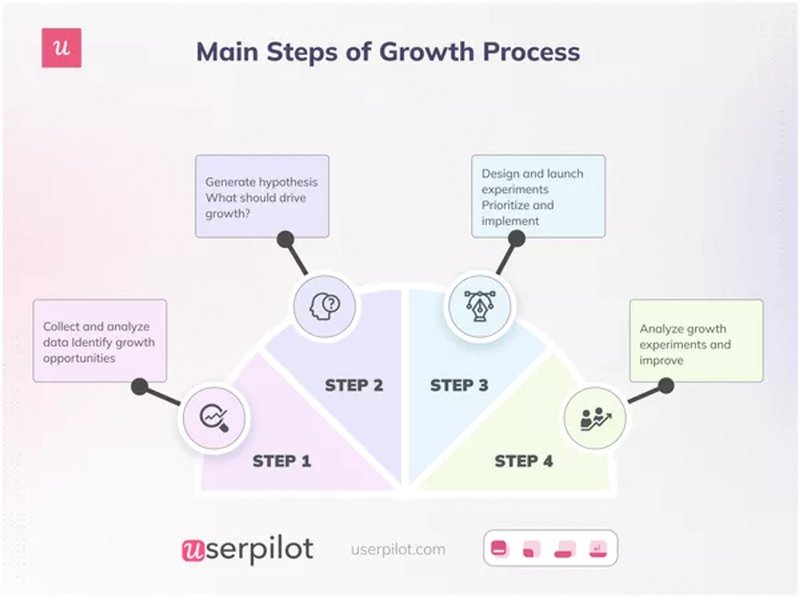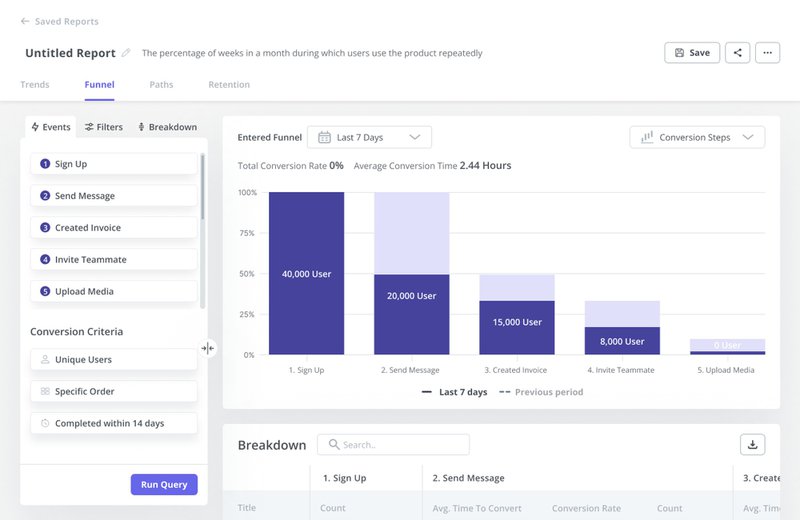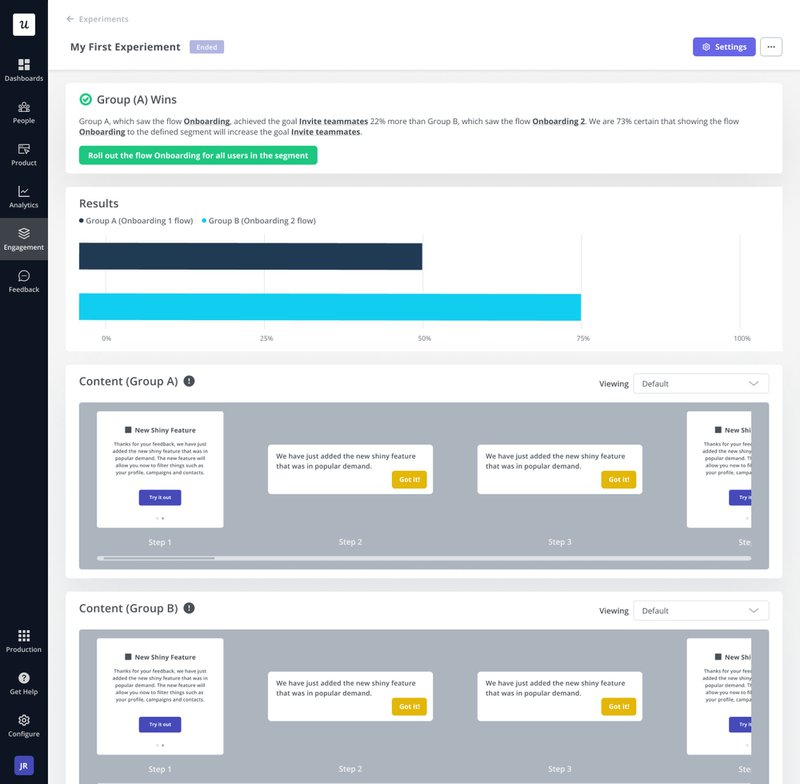
Try Userpilot Now
See Why 1,000+ Teams Choose Userpilot

What is growth marketing?
Growth marketing is more than just marketing a product; it’s a dynamic marketing strategy enabling businesses to flourish by fostering customer loyalty.
Growth marketing emphasizes enhancing customer lifetime value and retention, driving unparalleled growth through rigorous experimentation.
Rather than merely promoting a product or service, growth marketing dives deep, harnessing tools such as A/B testing, email marketing, SEO, and robust data analysis.
The aim?
To craft more impactful, efficient strategies that not only capture but also sustain audience interest. This approach breaks the traditional mold by accelerating innovation cycles and sidestepping drawn-out endeavors.

What is a growth marketer?
A growth marketer is a specialized professional whose primary objective isn’t just to attract customers and maximize their value over time.
Their focus extends the marketing funnel beyond initial customer acquisition, diving deep into engagement, retention, and expansion. By understanding and responding to ever-changing customer behaviors and preferences, growth marketers ensure that businesses don’t just grow but thrive in competitive landscapes.
Their holistic approach bridges gaps between digital marketing, product, and user experience to foster long-term relationships and sustainable growth marketing opportunities.
Growth marketer vs product marketer vs traditional marketing manager
Different roles have emerged in the marketing world, each with its distinct focus and expertise. To understand the nuances, let’s dissect the core distinctions between a growth marketer, product marketer, and traditional marketing manager:
- Growth Marketer: Their realm is characterized by continuous experimentation. Instead of merely promoting a product or a brand, growth marketers delve into the intricacies of the entire customer journey. Their main goal is to drive business growth by attracting new customers and, more importantly, increasing retention. This involves a lot of A/B testing, tweaking, and refining strategies based on data and insights to ensure customers stay engaged and loyal over time.
- Product Marketer (PMMs): PMMs operate at the intersection of product development and its target audience. Their primary focus lies in activation and adoption. This means they strategize on how best to introduce a product to the market, ensuring that potential users are not only aware of it but are also motivated to use and adopt it. They bridge the gap between product features and customer needs, often working closely with product teams to shape the product based on feedback and market demand.
- Traditional Marketing Manager: Often seen as the custodians of classic marketing, their focus remains mainly on customer acquisition. Through traditional marketing campaigns—print, TV, or radio ads—they aim to introduce a brand or product to a broader audience, capturing their interest and converting them into customers. While their methods might be more conventional, their role remains pivotal in establishing brand presence and recognition.
The structure of a growth marketing team
In the realm of growth marketing, one size doesn’t fit all. A growth team’s structure varies based on your company’s scale and requisites. For burgeoning startups, roles may blend; the head growth marketer could double as the data analyst.
Conversely, larger businesses might bolster their ranks with designated roles for every function, even assimilating a Chief Growth Officer into the C-suite. This adaptability underscores the beauty of growth marketing: it’s not about the number of players but how they blend their efforts.
Here’s a snapshot of the typical figures that are part of a growth marketing team:
- Growth PM (Product Manager)
Entrusted with charting the overarching growth marketing strategy and its experimental trajectory.
Fuels team morale and ensures alignment with objectives and KPIs.
Acts as the nexus for inter-departmental collaborations.
In expansive organizations, a Chief Growth Officer, a C-suite magnate, helms the growth reins, with Growth PMs reporting to them. - Growth Marketer
Masters the art of devising and deploying marketing stratagems.
Utilizes a palette of channels—PPC, email marketing, content stratagems, or SEO—to captivate and enthrall users.
They anchor, monitor, and assess experimental performances within the app’s ecosystem. - Growth Data Analysts
Anchors the team’s empirical endeavors, collecting, dissecting, and presenting data.
Their insights, drawn from intricate data tapestries, illuminate paths for product evolution and prospective experiments. - Growth Engineer
Devises and refines software solutions to buttress growth drives.
Craft features and optimizations that enhance user interaction and steer them towards coveted outcomes. Moreover, without no-code tools, they lay the foundation for data extraction and interpretation. - Growth (UX) Designer
Sculpt user experiences that nudge users towards desired engagements, from free trial sign-ups to immersion in novel features.
Driven by data and user surveys, their designs display effectiveness coupled with delight, culminating in a product that’s not just useful but irresistibly engaging.
What does a growth marketer do?
Growth marketers may look different depending on what business you focus on. Our lens will focus on the SaaS growth marketer’s role, which mirrors many aspects found in the B2C sphere. The tactics might shift, but the objective remains: optimizing every customer journey step.
Collect and analyze data
Growth marketers, emphasizing adoption and retention, prioritize data collection and analytics.
By diving deep into this data, they discern patterns and areas of friction and challenges users face.
Each data point is a potential avenue for refinement, offering opportunities to better cater to users and improve their overall experience.

Build in-app experiences to engage customers
Engagement is the cornerstone of retention, and in the digital landscape, in-app experiences are pivotal. Growth marketers recognize this and, as a result, meticulously design various in-app flows.
These flows, tailored to captivate and guide, serve as dynamic pathways, ensuring users interact with the product and are consistently engaged, leading to deeper immersion and long-term loyalty.

Run experiments to improve customer experience
In the quest for optimization, experimentation is key. The central goal of a growth marketing manager is clear: stimulate and sustain growth.
To achieve this, they regularly A/B test different campaigns to pinpoint which strategies, designs, or features yield the best results, driving growth and enhancing the overall user experience.

Implementing marketing strategies meant to drive growth
Growth marketing extends to broader strategies that foster growth.
Be it the allure of a well-structured referral program or the strategic finesse of upselling and cross-selling marketing campaigns, growth marketers craft and implement plans that attract and maximize the potential value of every user, ensuring that growth is not just a goal but a continuous trajectory.
Skills and qualities to become a successful growth marketer
Growth marketers hinge on a specific set of skills and qualities that help them to be successful. Let’s dive deeper into these attributes and uncover what makes a growth marketer exceptional.
Growth marketers are data-driven
Intuition takes a backseat to hard facts. Making decisions grounded in data rather than relying on mere hunches ensures strategies are effective, targeted, and yield the desired results.
By constantly using customer data and seeking empirical evidence, growth marketers validate hypotheses and optimize campaigns precisely.
Growth marketers are strategic thinkers
It’s not just about running experiments; it’s about running the right ones. Growth marketers have an innate ability to determine specific parts of the sales funnel that promise the highest impact.
Instead of scattering their efforts, they thoroughly craft growth marketing and social media strategies, ensuring every move aligns with overarching goals.
Growth marketers understand product analytics
The language of growth marketing is bursting with numbers and patterns. Understanding product analytics is not just about sifting through vast datasets but also about determining what data matters most.
By grasping the significance of specific metrics and knowing the methodologies to collect them, growth marketers bridge the gap between data and actionable insights.
Growth marketers understand personas and the user onboarding journey
A product’s growth potential is closely tied to its users. To drive adoption and retention, growth marketers immerse themselves in user personas, Jobs to be Done (JTBD), use cases, and onboarding best practices.
Internalizing these concepts ensures experiences are crafted for any user and the right user every step of the way.
What is the average salary of a growth marketer?
The average salary for a growth marketer typically ranges between $55,000 to $100,000 annually.
This range can vary based on location, company size, and individual experience, but it provides a general insight into the compensation these professionals can expect.

Conclusion
The role of the growth marketer emerges as a linchpin, driving businesses from mere existence to exponential growth. Their unique blend of analytical insight, strategic foresight, and user-centric mindset enables them to navigate user journeys, optimizing each touchpoint.
As businesses aim to thrive in a saturated market, the insights, developing strategies, and methodologies adopted by growth marketers will continue to be pivotal. Whether you’re a budding startup or an established enterprise, understanding and leveraging the prowess of growth marketing can be the key to unlocking sustainable success in the digital age.
If you are a growth marketer looking for the best tool to help you with your role, consider Userpilot. Userpilot provides features like A/B testing, product analytics, and building and improving in-app experience, all via a no-code solution. Book a demo to find out more.






